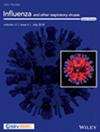Tracking Seasonal Influenza Trends in South Tyrol During 2022/2023 Using Genomic Surveillance Data
Abstract
Background
Influenza seasons are characterized by a complex interplay of co-circulating strains with high spatial and temporal heterogeneities. Surveillance is crucial for monitoring the spread and evolution of the virus and design effective public health response strategies.
Aim
We combined epidemiological, virological, and genomic surveillance data to provide a comprehensive analysis of influenza subtypes circulating in the South Tyrol region (Italy) during season 2022/2023, leveraging phylogenetic and phylodynamic approaches.
Methods
Clinical samples were collected from patients exhibiting influenza-like symptoms and evaluated by molecular diagnostics. Whole genome sequencing was conducted, and the hemagglutinin (HA) gene sequences were used for phylogenetic analysis. A birth–death skyline model was applied to estimate strain-specific effective reproduction numbers (Re) and attack rates.
Results
Out of 4891 samples tested, 862 tested positive for influenza, of which 224 genomes were sequenced. Phylogenetic analysis of HA gene revealed A(H3N2) strains predominantly clustering in clade 3C.2a1b.2a.2b, followed by 3C.2a1b.2a.1b. A(H1N1pdm09) strains predominantly clustered in clade 6B.1A.5a.2a. Exclusive circulation of B (Victoria) subtype strains aligned with the global trend, all falling within clade V1A.3a.2. Phylogenetic analyses indicate that the strains isolated in the South Tyrol region closely resembled those circulating in the rest of Italy and Austria. Re peaked at 1.16–1.35 (95%CI) for A(H3N2), 1.06–1.34 for A(H1N1pdm09) and 1.02–1.29 for B (Victoria). 95%CI of attack rates were 6.3%–33.5% for A(H3N2), 0.6%–5.0% for A(H1N1pdm09), and 0.8%–6.5% for B (Victoria).
Conclusion
Epidemiological estimates from traditional surveillance data can be corroborated by those derived from genomic sequencing, providing more robust assessments of viral transmissibility and attack rates with limited additional effort.


 求助内容:
求助内容: 应助结果提醒方式:
应助结果提醒方式:


